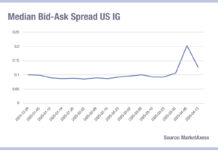Markets are truly feeling the economic pressures at present, with Moody’s downgrade to US financials on Monday following Fitch’s controversial downgrade of the US, and an already turbulent year for banks following the collapse of Silicon Valley Bank and the forced rescue of Credit Suisse by UBS.
Moody’s rating actions on 27 US banks were triggered by a decline in asset quality as risks around interest rate and asset-liability management (ALM) risks impact available liquidity and capital.

“Many banks’ Q2 results showed growing profitability pressures that will reduce their ability to generate internal capital,” wrote Jill Cetina and Ana Arsov of Moody’s Investor Services. “This comes as a mild US recession is on the horizon for early 2024 and asset quality looks set to decline from solid but unsustainable levels, with particular risks in some banks’ commercial real estate (CRE) portfolios.
Combined, these factors underpinned our 7 August rating actions on 27 US banks.” The net-net position is that lower margins matched with higher costs create issues for banks in their capital management, but also in a reputational sense. Both SVB and CS were hit by a sudden loss in client confidence. “Rising funding costs and declining income metrics will erode profitability, the first buffer against losses. US banks’ Q2 results broadly show a rapid rise in the cost of funding,” the Moody’s analysts noted. “Although the general drain on deposit funding caused by quantitative tightening (QT) moderated in Q2, there remains a significant risk that systemwide deposits will resume their decline in coming quarters.”
Falling profitability has already limited banks’ capital retention, and from a global perspective regional banks have relatively low regulatory capital levels to other US and global firms. “In the current high-rate environment, this leaves some banks with sizable unrealized economic losses that are not reflected in their regulatory capital ratios vulnerable to a loss of investor confidence,” they wrote. “Further, we expect a US recession in early 2024 will worsen banks’ asset quality and increase the potential for capital erosion. A proposed increase in regulatory capital requirements for all banks with assets above $100 billion is credit positive, but in the near term will come with increased regulatory costs and may entail business model changes that strain some banks’ profitability. Further, regulatory tailoring that sets lower capital and liquidity requirements for banks with less than $100 billion in assets is credit negative, and weaker regulations can promote excessive risk-taking at some banks.”
The effect of the downgrades, according to research analysts at Morgan Stanley, will be:
• Increase in debt funding costs weighing on net interest margins (NIM). Spreads will be higher on any debt issuance from banks as they diversify their funding base and as TLAC rules are expanded to a broader set of banks.
• Buybacks are likely to be suspended for longer as banks accrete capital ahead of proposed capital rule changes to support credit ratings.
• Banks are likely to double down on conserving RWA, as another means of supporting capital ratios. This should include running off / selling non-core parts of their loan portfolios, which they note is already reported in some bank earnings calls.
• At the margin, some municipal or institutional depositors may move deposits based on a downgrade, although MS notes its understanding is that most are only concerned with the actual level of the rating, which is still well above non-investment grade / highly rated at A1-A3).
©Markets Media Europe 2023
©Markets Media Europe 2025



























